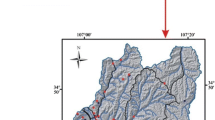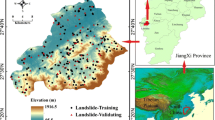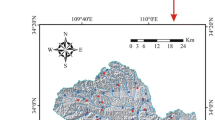The main goal of this study is to produce landslide susceptibility map using GIS-based support vector machine (SVM) at Kalaleh Township area of the Golestan province, Iran. In this paper, six different types of kernel classifiers such as linear, polynomial degree of 2, polynomial degree of 3, polynomial degree of 4, radial basis function (RBF) and sigmoid were used for landslide susceptibility mapping. At the first stage of the study, landslide locations were identified by aerial photographs and field surveys, and a total of 82 landslide locations were extracted from various sources. Of this, 75% of the landslides (61 landslide locations) are used as training dataset and the rest was used as (21 landslide locations) the validation dataset. Fourteen input data layers were employed as landslide conditioning factors in the landslide susceptibility modelling. These factors are slope degree, slope aspect, altitude, plan curvature, profile curvature, tangential curvature, surface area ratio (SAR), lithology, land use, distance from faults, distance from rivers, distance from roads, topographic wetness index (TWI) and stream power index (SPI). Using these conditioning factors, landslide susceptibility indices were calculated using support vector machine by employing six types of kernel function classifiers. Subsequently, the results were plotted in ArcGIS and six landslide susceptibility maps were produced. Then, using the success rate and the prediction rate methods, the validation process was performed by comparing the existing landslide data with the six landslide susceptibility maps. The validation results showed that success rates for six types of kernel models varied from 79% to 87%. Similarly, results of prediction rates showed that RBF (85%) and polynomial degree of 3 (83%) models performed slightly better than other types of kernel (polynomial degree of 2 = 78%, sigmoid = 78%, polynomial degree of 4 = 78%, and linear = 77%) models. Based on our results, the differences in the rates (success and prediction) of the six models are not really significant. So, the produced susceptibility maps will be useful for general land-use planning.















Similar content being viewed by others
References
Akgun A 2011 A comparison of landslide susceptibility maps produced by logistic regression, multi-criteria decision, and likelihood ratio methods: A case study at İzmir, Turkey; Landslides, doi: 10.1007/s10346-011-0283-7.
Akgun A and Bulut F 2007 GIS-based landslide susceptibility for Arsin-Yomra (Trabzon, North Turkey) region; Environ. Geol. 51(8) 1377–1387.
Akgun A and Turk N 2010 Landslide susceptibility mapping for Ayvalik (Western Turkey) and its vicinity by multi criteria decision analysis; Environ. Earth Sci. 61(3) 595–611.
Akgun A, Dag S and Bulut F 2008 Landslide susceptibility mapping for a landslide-prone area (Findikli, NE of Turkey) by likelihood frequency ratio and weighted linear combination models; Environ. Geol. 54(6) 1127–1143.
Akgun A, Kıncal C and Pradhan B 2011a Application of remote sensing data and GIS for landslide risk assessment as an environmental threat to Izmir city (west Turkey); Environ. Monit. Assess., doi: 10.1007/s10661-011-2352-8.
Akgun A, Sezer E A, Nefeslioglu H A, Gokceoglu C and Pradhan B 2011b An easy-to-use MATLAB program (MamLand) for the assessment of landslide susceptibility using a Mamdani fuzzy algorithm; Comput. Geosci. 38(1) 23–34.
Althuwaynee O F, Pradhan B and Lee S 2012 Application of an evidential belief function model in landslide susceptibility mapping; Comput. Geosci. 44 120–135, doi: 10.1016/j.cageo.2012.3.
Ayalew L and Yamagishi H 2005 The application of GIS-based logistic regression for landslide susceptibility mapping in the Kakuda-Yahiko Mountains, Central Japan; Geomorphology 65(1/2) 15–31.
Ayalew L, Yamagishi H, Marui H and Kanno T 2005 Landslide in Sado Island of Japan: Part II. GIS-based susceptibility mapping with comparison of results from two methods and verifications; Eng. Geol. 81 432–445.
Beven K and Kirkby M J 1979 A physically based, variable contributing area model of basin hydrology; Hydrol. Sci. Bull. 24 43–69.
Bui D T, Pradhan B, Lofman O, Revhaug I and Dick O B 2011 Landslide susceptibility mapping at Hoa Binh province (Vietnam) using an adaptive neuro-fuzzy inference system and GIS; Comput. Geosci., doi: 10.1016/j.cageo.2011.10.031.
Bui D T, Pradhan B, Lofman O and Revhaug I 2012a Landslide susceptibility assessment in Vietnam using support vector machines, decision tree and Naïve Bayes models; Math. Problems in Eng., http://www.hindawi.com/journals/mpe/aip/974638/.
Bui D T, Pradhan B, Lofman O, Revhaug I and Dick O B 2012b Landslide susceptibility assessment in the Hoa Binh province of Vietnam using Artificial Neural Network; Geomorphology, doi: 10.1016/j.geomorph.2012.04.023.
Bui D T, Pradhan B, Lofman O, Revhaug I and Dick O B 2012c Spatial prediction of landslide hazards in Vietnam: A comparative assessment of the efficacy of evidential belief functions and fuzzy logic models; Catena 96 28–40.
Christianini N and Shawe-Taylor J 2000 An introduction to Support Vector Machines; Cambridge University Press; ISBN 0521780195.
Dai F C and Lee C F 2002 Landslide characteristics and slope instability modeling using GIS, Lantau Island, Hong Kong; Geomorphology 42 213–228.
Devkota K C, Regmi A D, Pourghasemi H R, Yoshida K, Pradhan B, Ryu I C, Dhital M R and Althuwaynee O F 2012 Landslide susceptibility mapping using certainty factor, index of entropy and logistic regression models in GIS and their comparison at Mugling-Narayanghat road section in Nepal Himalaya; Nat. Hazards, doi: 10.1007/s11069-012-0347-6.
ENVI Version 4.3, 2006. ITT industires, Inc. http://www.RSInc.com/envi.
Ercanoglu M and Gokceoglu C 2002 Assessment of landslide susceptibility for a landslide-prone area (North of Yenice, NW Turkey) by fuzzy approach; Environ. Geol. 41 720–730.
Ercanoglu M and Gokceoglu C 2004 Use of fuzzy relations to produce landslide susceptibility map of a landslide prone area (West Black Sea Region, Turkey); Eng. Geol. 75 229–250.
Gokceoglu C, Sonmez H and Ercanoglu M 2000 Discontinuity controlled probabilistic slope failure risk maps of the Altindag (settlement) region in Turkey; Eng. Geol. 55 277–296.
Golestan Regional Water Co. 2007 Golestan province meteorological information report.
Gomez H and Kavzoglu T 2005 Assessment of shallow landslide susceptibility using artificial neural networks in Jabonosa River Basin, Venezuela; Eng. Geol. 78 11–27.
Gritzner M L, Marcus W A, Aspinall R and Custer S G 2001 Assessing landslide potential using GIS, soil wetness modeling and topographic attributes, Payette River, Idaho; Geomorphology 37 149–165.
Guzzetti F, Carrara A, Cardinalli M and Reichenbach P 1999 Landslide hazard evaluation: A review of current techniques and their application in a multi-case study, central Italy; Geomorphology 31 181–216.
Hengl T, Gruber S and Shrestha D P 2003 Digital Terrain Analysis in ILWIS. International Institute for Geo-Information Science and Earth Observation Enschede (The Netherlands), 62p.
Iranian Landslide working party 2007 Iranian landslides list, Forest, Rangeland and Watershed Association, Iran, p. 60.
Jenness J 2002 Surface Areas and Ratios from Elevation Grid, Jenness Enterprises, http://www.jennessent.com/arcview/surface_areas.htm (connected: 10.08.2003).
Kanevski M, Pozdnoukhov A and Timonin V 2009 Machine Learning for Spatial Environmental Data: Theory, Applications and Software; CRC Press.
Lee S and Pradhan B 2006 Probabilistic landslide risk mapping at Penang Island, Malaysia; J. Earth Syst. Sci. 115(5) 661–672.
Lee S and Pradhan B 2007 Landslide hazard mapping at Selangor, Malaysia using frequency ratio and logistic regression models; Landslides 4 33–41.
Lee S, Ryu J H, Won J S and Park H J 2004 Determination and application of the weights for landslide susceptibility mapping using an artificial neural network; Eng. Geol. 71 289–302.
Marjanović M, Kovaèević M, Bajat B and Voženílek V 2011 Landslide susceptibility assessment using SVM machine learning algorithm; Eng. Geol. 123 225–234.
Micheletti N 2011 Landslide susceptibility mapping using adaptive support vector machines and feature selection, A Master Thesis submitted to University of Lausanne Faculty of Geosciences and Environment for the Degree of Master of Science in Environmental Geosciences, 99p.
Moore I D, Grayson R B and Ladson A R 1991 Digital terrain modeling: A review of hydrological, geomorphological, and biological applications; Hydrol. Proc. 5 3–30.
Muthu K, Petrou M, Tarantino C and Blonda P 2008 Landslide possibility mapping using fuzzy approaches; IEEE Trans. Geosci. Remote Sens. 46 1253–1265.
Nefeslioglu H A, Gokceoglu C and Sonmez H 2008 An assessment on the use of logistic regression and artificial neural networks with different sampling strategies for the preparation of landslide susceptibility maps; Eng. Geol. 97 171–191.
Nefeslioglu H A, Sezer E, Gokceoglu C, Bozkir A S and Duman T Y 2010 Assessment of landslide susceptibility by decision trees in the Metropolitan Area of Istanbul, Turkey; Math. Problems Eng. Volume, doi: 10.1155/2010/901095.
Oh H J and Pradhan B 2011 Application of a neuro-fuzzy model to landslide susceptibility mapping for shallow landslides in tropical hilly area; Comput. Geosci. 37(9) 1264–1276.
Pachauri A K, Gupta P V and Chander R 1998 Landslide zoning in a part of the Garhwal Himalayas; Environ. Geol. 36(3–4) 325–334.
Pourghasemi H R, Pradhan B, Gokceoglu C, Mohammadi M and Moradi H R 2012a Application of weights-of-evidence and certainty factor models and their comparison in landslide susceptibility mapping at Haraz watershed, Iran; Arab. J. Geosci., doi: 10.1007/s12517-012-0532-7.
Pourghasemi H R, Pradhan B, Gokceoglu C and Deylami Moezzi K 2012b A comparative assessment of prediction capabilities of Dempster-Shafer and Weights-of-evidence models in landslide susceptibility mapping using GIS; Geomatics, Nat. Hazards Risk, doi: 10.1080/19475705.2012.662915.
Pourghasemi H R, Pradhan B and Gokceoglu C 2012c Application of fuzzy logic and analytical hierarchy process (AHP) to landslide susceptibility mapping at Haraz watershed, Iran; Nat. Hazards 63(2) 965–996.
Pourghasemi H R, Gokceoglu C, Pradhan B and Deylami Moezzi K 2012d Landslide susceptibility mapping using a spatial multicriteria evaluation model at Haraz Watershed, Iran; (eds) Pradhan B and Buchroithner M, Terrigenous Mass Movements (Berlin Heidelberg: Springer- Verlag), pp. 23–49, doi: 10.1007/978-3-642-25495-6-2.
Pourghasemi H R, Mohammady M and Pradhan B 2012e Landslide susceptibility mapping using index of entropy and conditional probability models in GIS: Safarood Basin, Iran; Catena 97 71–84.
Pradhan B 2010a Application of an advanced fuzzy logic model for landslide susceptibility analysis; Int. J. Comput. Intel. Sys. 3(3) 370–381.
Pradhan B 2010b Landslide susceptibility mapping of a catchment area using frequency ratio, fuzzy logic and multivariate logistic regression approaches; J. Indian Soc. Rem. Sen. 38(2) 301–320.
Pradhan B 2010c Remote sensing and GIS-based landslide hazard analysis and cross-validation using multivariate logistic regression model on three test areas in Malaysia; Adv. Space Res. 45(10) 1244–1256.
Pradhan B 2011a Manifestation of an advanced fuzzy logic model coupled with geoinformation techniques coupled with geoinformation techniques for landslide susceptibility analysis; Environ. Ecol. Stat. 18(3) 471–493, doi: 10.1007/s10651-010-0147-7.
Pradhan B 2011b Use of GIS-based fuzzy logic relations and its cross application to produce landslide susceptibility maps in three test areas in Malaysia; Environ. Earth Sci. 63(2) 329–349.
Pradhan B and Buchroithner M F 2010 Comparison and validation of landslide susceptibility maps using an artificial neural network model for three test areas in Malaysia. Environ. Eng. Geosci. 16(2) 107–126, doi: 10.2113/gseegeosci.16.2.107.
Pradhan B and Lee S 2009 Landslide risk analysis using artificial neural network model focusing on different training sites; Int. J. Physic. Sci. 3(11) 1–15.
Pradhan B and Lee S 2010a Landslide susceptibility assessment and factor effect analysis: Back propagation artificial neural networks and their comparison with frequency ratio and bivariate logistic regression modeling; Environ. Modell. Softw. 25 747–759.
Pradhan B and Lee S 2010b Delineation of landslide hazard areas using frequency ratio, logistic regression and artificial neural network model at Penang Island, Malaysia; Environ. Earth Sci. 60 1037–1054.
Pradhan B and Pirasteh S 2010 Comparison between prediction capabilities of neural network and fuzzy logic techniques for landslide susceptibility mapping; Disaster Adv. 3(2) 26–34.
Pradhan B and Youssef A M 2010 Manifestation of remote sensing data and GIS on landslide hazard analysis using spatial-based statistical models; Arab. J. Geosci. 3(3) 319–326.
Pradhan B, Singh R P and Buchroithner M F 2006 Estimation of stress and its use in evaluation of landslide prone regions using remote sensing data; Adv. Space Res. 37 698–709.
Pradhan B, Lee S, Mansor S, Buchroithner M F, Jallaluddin N and Khujaimah Z 2008 Utilization of optical remote sensing data and geographic information system tools for regional landslide hazard analysis by using binomial logistic regression model; Appl. Remote Sens. 2 1–11.
Pradhan B, Lee S and Buchroithner M B 2009 Use of geospatial data for the development of fuzzy algebraic operators to landslide hazard mapping: A case study in Malaysia; Appl. Geomatics 1 3–15.
Pradhan B, Sezer E, Gokceoglu C and Buchroithner M F 2010a Landslide susceptibility mapping by neuro-fuzzy approach in a landslide prone area (Cameron Highland, Malaysia); IEEE Trans. Geosci. Remote Sens. 48(12) 4164–4177.
Pradhan B, Youssef A M and Varathrajoo R 2010b Approaches for delineating landslide hazard areas using different training sites in an advanced artificial neural network model; Geospatial Information Sci. 13(2) 93–102.
Pradhan B, Lee S and Buchroithner M F 2010c Remote sensing and GIS based landslide susceptibility analysis and its cross-validation in three test areas using a frequency ratio model; Photogramm. Fernerkundung Geoinformation 1 17–32, doi: 10.1127/14328364/2010/0037.
Pradhan B, Oh H J and Buchroithner M 2010d Weights-of-evidence model applied to landslide susceptibility mapping in a tropical hilly area; Geomatics, Nat. Hazards Risk 1(3) 199–223, doi: 10.1080/19475705.2010.498151.
Pradhan B, Mansor S, Pirasteh S and Buchroithner M 2011 Landslide hazard and risk analyses at a landslide prone catchment area using statistical based geospatial model; Int. J. Remote Sens. 32(14) 4075–4087, doi: 10.1080/01431161.2010.484433.
Pradhan B, Chaudhari A, Adinarayana J and Buchroithner M F 2012 Soil erosion assessment and its correlation with landslide events using remote sensing data and GIS: A case study at Penang Island, Malaysia; Environ. Monit. Assess. 184(2) 715–727.
Sezer E A, Pradhan B and Gokceoglu C 2011 Manifestation of an adaptive neuro-fuzzy model on landslide susceptibility mapping: Klang valley, Malaysia; Expert Syst. Appl. 38(7) 8208–8219.
Shou K J and Wang C F 2003 Analysis of the Chiufengershan landslide triggered by the 1999 Chi–Chi earthquake in Taiwan; Eng. Geol. 68 237–250.
Talebi A, Uijlenhoet R and Troch P A 2007 Soil moisture storage and hillslope stability; Nat. Hazards Earth Syst. Sci. 7 523–534.
Tunusluoglu M C, Gokceoglu C, Nefeslioglu H A and Sonmez H 2008 Extraction of potential debris source areas by logistic regression technique: A case study from Barla, Besparmak and Kapi mountains (NW Taurids, Turkey); Environ. Geol. 54 9–22.
Vahidnia M H, Alesheikh A A, Alimohammadi A and Hosseinali F 2010 A GIS-based neurofuzzy procedure for integrating knowledge and data in landslide susceptibility mapping; Comput. Geosci., doi: 10.1016/j.cageo.2010.04.004.
Van Den Eeckhaut M, Vanwalleghem T, Poesen J, Govers G, Verstraeten G and Vandekerckhove L 2006 Prediction of landslide susceptibility using rare events logistic regression: A case study in the Flemish Ardennes (Belgium); Geomorphology 76 392–410.
Varnes D J 1978 Slope movement types and processes; In: Landslide analysis and control (eds) Schuster R L and Krizek R J, Special Report. Transportation Research Board, National Academy of Sciences, New York, 176 12–33.
Vapnik V N 1995 The Nature of Statistical Learning Theory (New York: Springer Verlag).
Wang H B and Sassa K 2005 Comparative evaluation of landslide susceptibility in Minamata area, Japan; Environ. Geol. 47 956–966.
Xu C, Dai F, Xu X and Lee Y H 2012 GIS-based support vector machine modeling of earthquake-triggered landslide susceptibility in the Jianjiang River watershed, China; Geomorphology, doi: 10.1016/j.geomorph.2011.12.040.
Yalcin A and Bulut F 2007 Landslide susceptibility mapping using GIS and digital photogrammetric techniques: A case study from Ardesen (NE-Turkey); Nat. Hazards 41 201–226.
Yao X, Tham L G and Dai F C 2008 Landslide susceptibility mapping based on Support Vector Machine: A case study on natural slopes of Hong Kong, China; Geomorphology 101 572–582.
Yesilnacar E K 2005 The Application of Computational Intelligence to Landslide Susceptibility Mapping in Turkey; Ph.D Thesis, Department of Geomatics, University of Melbourne, 423p.
Yesilnacar E and Topal T 2005 Landslide susceptibility mapping: A comparison of logistic regression and neural networks methods in a medium scale study, Hendek region (Turkey); Eng. Geol. 79(3–4) 251–266.
Yilmaz I 2009a A case study from Koyulhisar (Sivas–Turkey) for landslide susceptibility mapping by artificial neural networks; Bull. Eng. Geol. Environ 68(3) 297–306.
Yilmaz I 2009b Landslide susceptibility mapping using frequency ratio, logistic regression, artificial neural networks and their comparison: A case study from Kat landslides (Tokat-Turkey); Comput. Geosci. 35(6) 1125–1138.
Yilmaz I 2010a The effect of the sampling strategies on the landslide susceptibility mapping by conditional probability (CP) and artificial neural network (ANN); Environ. Earth Sci. 60 505–519.
Yilmaz I 2010b Comparison of landslide susceptibility mapping methodologies for Koyulhisar, Turkey: Conditional probability, logistic regression, artificial neural networks, and support vector machine; Environ. Earth Sci. 61 821–836.
Youssef A M, Pradhan B, Gaber A F D and Buchroithner M F 2009 Geomorphological hazard analysis along the Egyptian Red Sea coast between Safaga and Quseir; Nat. Hazards Earth Syst. Sci. 9 751–766.
Zare M, Pourghasemi H R, Vafakhah M and Pradhan B 2012 Landslide susceptibility mapping at Vaz Watershed (Iran) using an artificial neural network model: A comparison between multilayer perceptron (MLP) and radial basic function (RBF) algorithms; Arab. J. Geosci., doi: 10.1007/s12517-012-0610-x.
Acknowledgements
Authors would like to thank two anonymous reviewers for their helpful reviews on the earlier version of the manuscript. Thanks to Dr Nibir Mandal for his valuable suggestions that improved the paper.
Author information
Authors and Affiliations
Corresponding author
Rights and permissions
About this article
Cite this article
POURGHASEMI, H.R., JIRANDEH, A.G., PRADHAN, B. et al. Landslide susceptibility mapping using support vector machine and GIS at the Golestan Province, Iran. J Earth Syst Sci 122, 349–369 (2013). https://doi.org/10.1007/s12040-013-0282-2
Received:
Revised:
Accepted:
Published:
Issue Date:
DOI: https://doi.org/10.1007/s12040-013-0282-2




